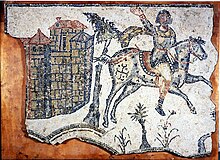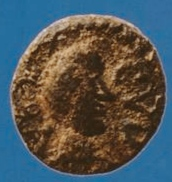Vandal Sardinia
Sardinia was overseen by a governor called a praeses, chosen from the trusted men of the royal family and resident in Caralis, who had both civil and military functions.
In 533, perhaps taking advantage of a remarkable autonomy, Godas, the Vandal governor of Goth origin, proclaimed himself king of the island,[8] minting his own bronze coins.
Justinian, Roman Emperor in Constantinople, purportedly to help Godas, decided to intervene and sent an army commanded by General Belisarius and assisted by Duke Cirillus.
Meanwhile, the King of Vandals, Gelimer, who was also facing a revolt in Tripoli, sent his brother Tzazo with a large contingent of 120 ships and 5,000 men to Sardinia to suppress Goda's uprising.
The Sardinian dioceses of the Roman period – Caralis, Forum Traiani, Sulci, Turris and Sanafer (and perhaps Cornus) – remained operative under the Vandals.
The funeral area of Sant'Imbenia at Alghero, the burial in Spina Santa near Sassari, and the tomb discovered at Sant'Antioco, where a man was buried with his horse, also appear to belong to the Vandal age.
[11] The historian Alberto Boscolo attributed to the Vandals the tombs with barrel vaults discovered in several island resorts, mainly in southern Sardinia.
[11] There is no evidence of a Vandal superstrate in the Sardinian language, however some influences of the African Romance could date back to this historical phase such as the i prothesis in words like i-scola (school, from the Latin schola).
[13] The settlement of people of Germanic origin in Sardinia is testified by some anthroponyms such as Othila, owner of a latifundium near Fiume Santo, Iesumundus, a nine-year-old child buried in Cagliari at the beginning of the 6th century AD, Patriga, a young noblewoman buried in Cornus-Columbaris in a "capuchin tomb",[14] and Waldaric, of whom we find news in a letter addressed to Pope Gregory the Great asking him to intercede with the Byzantine Dux so that he could return to the island to his wife.
The fall of the Vandal kingdom in Africa around 534 AD led to a progressive decline in exports of African products and important consequences at a political level.







